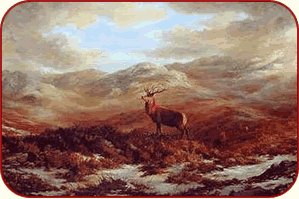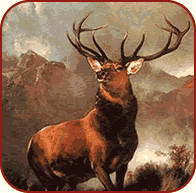
| Deer in Northern Ireland
by BR Three species of deer inhabit Northern Ireland - Red, Fallow and Japanese Sika. There are no Roe Deer on the island of Ireland. Red Deer derive from introductions, mostly
from Scotland. Fallow Deer were introduced by the Normans in the13th
century in Counties Wicklow and Waterford, and are now widespread
throughout the country. This is not surprising when one considers
that Fallow were usually the deer kept in deer parks of the large
estates. |
|
|
With the increased demand for venison, Deer Farms have appeared throughout Northern Ireland. They are stocked with either Red Deer or Fallow Deer. In addition to the wild deer throughout the six counties, we must consider the deer confined within the various large deer parks and estates. To me the most important and finest herd is the Red Deer Herd owned and maintained by His Grace the Earl of Caledon on his beautiful estate at Caledon. Stop on the country road during the rut in October, and you will hear the stags roaring their challenge to each other. The lucky people will be the ones that get a glimpse of these majestic animals. The chosen ones are the members of the Northern Ireland Deer Society who assist estate staff with the tagging of the "Bambie" calves in early June. Go on join the Society and get the opportunity to see the most beautiful animal in this country for yourself. Private deer herds of Sika are maintained at Colebrooke Estate and Baronscourt Estate in County Fermanagh, and Fallow Deer at Shanes Castle Estate in County Antrim and Clandeboye Estate in County Down. There is also a small herd of Red Deer on Seaforde Estate, which is also in County Down. The National Trust maintains a small enclosed herd of Fallow Deer at Crom Castle in County Fermanagh. For the general public Fallow Deer can be seen, if you are very lucky, in Tollymore Forest and Randalstown Forest. Sika Deer can be seen in Gortin Glen Forest, and if you want to see the majestic Red, call in at Gosford Forest Park in County Armagh. Perhaps the most interesting and genetically valuable herd is that of the White Fallow at Parkanaur Forest Park in County Tyrone. They are direct descendants of the White Fallow from Mallow Castle in County Cork, the oldest park herd of deer in Ireland. For the protection and good of the deer they must be managed. Basically in Northern Ireland all deer control and culling is carried on in house, either by estate stalkers on private estates, or by wildlife wardens within the Northern Ireland Forest Services. All shooting is done with full-bore rifles, the most popular calibre being either .243 or.270. There is no leased deer stalking in Northern Ireland. Perhaps the unique security situation in this country has largely precluded the casual sporting use of the full-bore rifle. All the deer herd owners wish to maintain full control of the cull - both the selection of the animals which make up the herd and the total number of deer to be taken out. That is not to say that the private amateur stalker does not have the opportunity to stalk deer in Northern Ireland. Northern Ireland Forest Services operates a day permit system whereby anyone suitably equipped, and most importantly, skilled and insured, can make application for an outing with a trained wildlife warden and assist with part of the cull within the forest services. There is no unescorted stalking, and the warden will select the animal to be culled. Payment is for a standard 3 hours outing, plus a trophy fee depending on the quality of the animal shot. To the best of my knowledge only two private estates - Baronscourt and Colebrooke - offer deer stalking. These are generally geared to a residential weekly package. High demand from continental stalkers means the market is usually fully booked. Most of the stags are shot from high seats. The hinds (females) are taken by estate stalkers. Stalking in Northern Ireland is woodland stalking. There is no traditional open hill stalking as in Scotland. A high percentage of the deer shot in Northern
Ireland are sold locally for venison. The remainder of the cull
is mostly sold to game dealers in Scotland. Local demand for wild
venison from Hotels, Restaurants and retail butchers is high for
two main reasons: With the increase in cookery programmes on television, and the vast selection of recipe books on the market, the many amateur chefs are experimenting with new dishes. Current Government policy to increase afforestation throughout Northern Ireland means an increase in suitable deer habitat and this in turn gives us, the public, more opportunity to see deer. Those of us who study and observe deer know only too well that deer have much better eyesight than the human; therefore practice the skills and see the deer for yourselves, it really is well worth while. When did you last see a wild deer? They are there and I bet they saw you. Many years ago when I first became interested in deer, I was given the opportunity to access woodlands on which there was a small herd of wild Fallow. A local gave me sound advice: "when you're moving you are making a noise, so spend more time looking and listening than walking", so off to the woods I went! As we approached the area on a late, still, cloudless September morning, driving up a long lane we saw a commotion on a large bank. Slowing down to a crawl, we made our approach and observed a unique spectacle, a Honey Buzzard attacking a wild bee's nest. Small sods flying everywhere and hundreds of bees in the air- car windows were shut tight. We sat for ages watching and eventually he reached the honeycomb which he started to eat. We had spent long enough so, releasing the hand- brake, we free-wheeled past without disturbing morning breakfast. Going into the woods I went off in my chosen direction. Walking slowly for about 20 minutes, I found a big flat stone at the base of a Larch tree and sat down. Around me was an area of open mature Larch with a very thick carpet of bright green moss. Time passed, and there I relaxed listening to the sounds of the forest. Suddenly from the corner of my eye I detected a movement. Slowly turning my head I saw a pair of Pine Martens, about 15-20 yards away, playing in the thick moss like two otters. I relaxed even more and watched, not having a camera to distract me. I enjoyed the whole experience until they had had enough and continued on their morning search for breakfast, out of my sight. Being content with my lot, I remained on my stone seat listening and watching, when over my shoulder I heard the crack of twig - what was the next excitement to come? One crack, then another and another, but still I didn't move, hardly even breathing. Eventually curiosity got the better of me. I slowly turned my head under the broad-rimmed hat. At first I saw nothing and thought the woods were playing tricks, but on a closer look I detected a movement. Concentration produced a pair of long ears. These ears eventually developed from behind a fallen and moss-covered trunk into the most beautiful 4-months old fallow calf. His natural defence had not detected me, so motionless and holding my breath. I watched him browse and nibble. For some reason he appeared to be on his own. He continued to browse closer and closer to me, eventually moving to within 10 or 12 feet of me, and then lifting his head in that angular, inquisitive way, stared straight at me, decided I should not be there, turned and departed in a slow, stilted bounce, reminiscent of deer and antelope. That day has stayed clear in my mind for 35 years. |
|
 Valley of the Stags by Elizabeth Halstead (Click image to enlarge) |
|
| The illustrations in this article were taken from fine art prints from Allposters.com the world's largest fine art print and poster store. To see the full range of prints and posters available see the ALLPOSTERS search engine on our Art pages. | |
|
|
|
